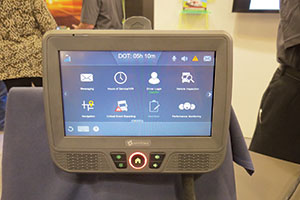Managing Editor, Features and Multimedia
Omnitracs Debuts Next-Gen Telematics System

DALLAS — Omnitracs has unveiled its next-generation telematics platform, which introduces voice recognition and expands wireless connectivity within the truck.
The Intelligent Vehicle Gateway, or IVG, features voice-command software that allows drivers to keep their eyes on the road and hands on the wheel while interacting with the system, Omnitracs announced here at its 2016 user conference.
Drivers can use the “intelligent voice interface” to perform functions such as checking their driving hours or accessing messages by speaking commands to the in-cab unit, similar to “Siri” on Apple devices.
Chief Technology Officer Dan Speicher said the new platform also will act as a “communications hub” that will connect with a growing number of sensors and devices on the truck, including smartphones, tablets, onboard cameras, wearables and fuel monitors.
With the launch of the platform, Omnitracs has introduced its first wave of major product releases since the company’s spinoff from Qualcomm Inc. in November 2013.
CEO John Graham said Omnitracs has ramped up its investments in product development. The company spent $50 million on research and development last year and plans to increase that to $70 million in 2016, he said.
The IVG, which begins shipping in March, is the successor to Omnitracs’ flagship Mobile Computing Platform line of onboard computers.
Unlike the MCP line, which is available in a variety of models, the IVG uses one standard set of hardware, which allows for faster development of new features and functionality, Speicher said. It features a larger display, Bluetooth and Wi-Fi hot spot capabilities as well as high-powered speakers designed to be audible in a noisy trucking environment.
Omnitracs also outlined plans to release its own onboard video system, expanding the list of vendors targeting the growing onboard camera market. Omnitracs’ Critical Event Video product will enable fleets to download video captured a few seconds before and after a crash or other event to recreate the incident, Speicher said. Other plans include an application to help drivers locate available parking spaces.
Omnitracs also is expanding its diagnostics partnership with engine maker Cummins Inc. to provide over-the-air updates, a feature the companies aim to launch later this year, said Jeff Champa, senior director of product development.
Omnitracs is preparing to release its own truck-specific navigation application as well.
That navigation software, first unveiled in October at American Trucking Associations’ Management Conference & Exhibition, will be available by the end of February on the MCP200 and MCP110 platforms and also for the MCP50, IVG, Android and Apple’s iOS by the end of July, said Rick Turek, chief navigation scientist at Omnitracs. The company will continue to support third-party navigation applications.
Speicher said Omnitracs also plans to develop more technology options beyond the cab to help drivers perform tasks outside the truck.
That type of functionality is high on the wish list for conference attendee Neil Evans, director of operations at Highway Transport Chemical, a tanker fleet based in Knoxville, Tennessee. Evans said the ability to handle bills of lading electronically and capture customers’ signatures on a device outside the truck would help streamline his fleet’s operations.
During the conference, Graham recapped Omnitracs’ move to consolidate the technology firms it has acquired in recent years, including XRS, Roadnet, Sylectus and Omnitracs Analytics, under a unified brand.
“We’ve brought the company under one roof, one house, and we envision interoperability amongst a lot of those technologies,” he said.
Omnitracs has about doubled its global employee base over the past two years to nearly 1,100 workers, Graham added.
Looking ahead, Graham said the growth of data analytics and predictive algorithms will enable fleets to derive more value from the information captured by their technology.
“This is an arena that’s going to drive your business and our business for a long, long time,” he said, adding that such data can play a role in the development of autonomous driving and platooning capabilities.
Despite the launch of its new proprietary telematics platform, Speicher said, Omnitracs also aims to make its software more “hardware agnostic” by increasingly offering its applications on third-party hardware.
The company’s XRS product line, for example, runs on smartphones and tablets.
Omnitracs also is working to strengthen its relationships with original equipment manufacturers, which are increasingly building telematics hardware into their vehicles, Speicher said.
The company has partnered with Volvo Trucks and Mack Trucks to offer software applications that run on the built-in telematics hardware in their vehicles.


